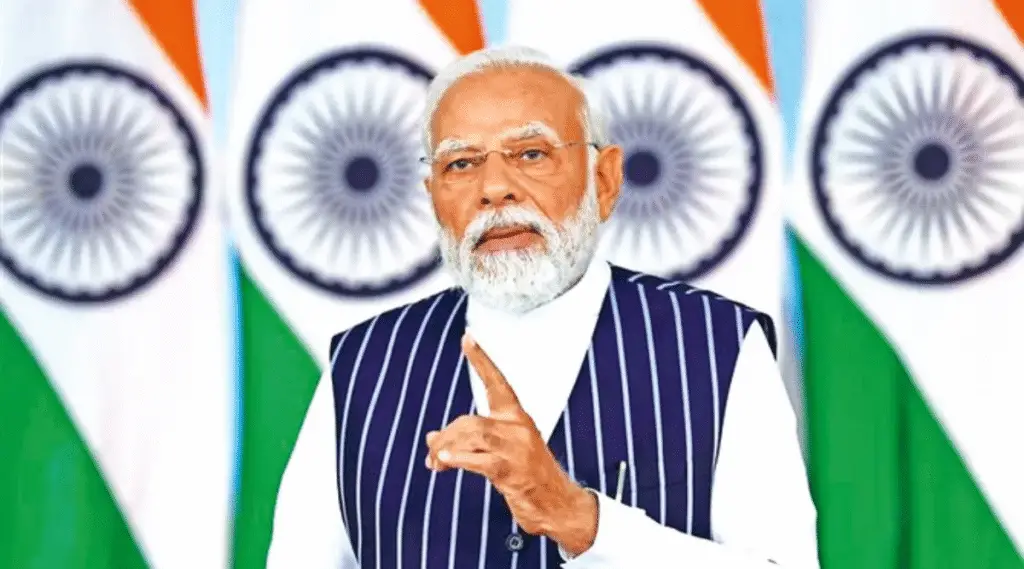In a surprising statement made during a business engagement in Qatar, former U.S. President Donald Trump claimed that India had proposed a trade deal with zero tariffs. The comments, delivered to a group of influential business leaders, stirred immediate interest and skepticism across both diplomatic and economic spheres.
“The Indian government has offered us a deal where basically they are willing to literally charge us no tariff,” Trump asserted, emphasizing the magnitude of what would be a major policy shift between the two nations.
India’s Ministry of Commerce quickly responded—not with denial, but with measured ambiguity. Officials refrained from confirming or denying Trump’s claim, merely noting that details of ongoing trade negotiations cannot be disclosed at this stage.
A Bold Claim or Strategic Bluff?
If true, this zero-tariff deal could mark a monumental evolution in Indo-U.S. trade relations, which have historically been marked by tariff asymmetries, long-standing negotiation hurdles, and geopolitical complexity.
However, insiders familiar with ongoing diplomatic conversations told Hindustan Times that no such explicit offer of “zero tariffs” had been made in any recent dialogue between Indian and American officials. According to these sources, current negotiations are still centered around the first phase of a broader bilateral trade agreement, tentatively slated for conclusion by the fall of 2025, following the Trump-Modi summit earlier in the year.
“It’s premature to claim there’s any finalized agreement, let alone one as sweeping as zero tariffs,” noted a senior Indian trade official.
This suggests that Trump’s remarks may be more reflective of political posturing and strategic rhetoric rather than any binding offer currently on the table.
U.S.-India Trade Talks: Where Do They Stand?
Negotiations for a comprehensive Indo-U.S. trade agreement have spanned several years, with issues like agricultural access, digital trade, data privacy, e-commerce regulation, and intellectual property rights forming the crux of the discussions. The two nations have shared mutual aspirations to deepen their economic and defense ties, but tariff parity and market access remain sticking points.
India has long maintained higher import tariffs on certain U.S. goods, including agricultural products, medical devices, and motorcycles, while the U.S. has imposed duties on Indian aluminum and steel. The idea of India eliminating tariffs altogether would be unprecedented and would certainly require extensive legislative and bureaucratic restructuring.
Apple and India: A Trade Detour?
In another unexpected revelation, Trump claimed he personally persuaded Apple CEO Tim Cook to scale back plans to expand manufacturing in India.
“I said I don’t want you building in India. We want those jobs in the United States,” Trump stated, implying that Apple would instead increase domestic production.
This assertion starkly contradicts Apple’s current trajectory. The tech giant has significantly invested in India, where it already assembles several iPhone models through Foxconn and Wistron. Apple has also opened flagship retail stores in Mumbai and Delhi and is reportedly aiming to make India a key global manufacturing base, particularly as the company diversifies away from China due to geopolitical tensions and supply chain disruptions.
If Trump’s influence did, in fact, dissuade Apple from further investment in India, it could pose a challenge to Prime Minister Narendra Modi’s “Make in India” initiative, which has been aggressively promoting India as a global electronics manufacturing hub.
Epic Claims on South Asia Peace: Trump Credits Himself for Indo-Pak Ceasefire

Taking credit for diplomatic stability in South Asia, Trump claimed his administration’s efforts helped de-escalate rising tensions between India and Pakistan, particularly in reference to the ceasefire agreement announced in early 2021.
“We stopped a nuclear conflict. I think it could have been a bad nuclear war—millions of people could have been killed,” Trump said, attributing the breakthrough to his administration’s trade and diplomatic outreach.
However, Indian officials immediately rejected this version of events. According to the Ministry of External Affairs, the ceasefire was a bilateral decision made after direct communication between the Directors General of Military Operations (DGMOs) of both nations. There was no involvement from U.S. officials, and no trade negotiations were part of the process.
“The ceasefire was achieved through mutual understanding and direct military communication. No third-party mediation was involved,” said an Indian defense spokesperson.
This marks yet another instance where Trump’s narrative diverges from documented diplomatic processes, raising questions about the accuracy and intent of his public statements.
Kashmir and the Mediation Mirage: India Reasserts Its Stance
During his presidency, Trump often floated the idea of mediating between India and Pakistan, especially over the long-standing Kashmir dispute. He reignited the topic during his Qatar remarks, suggesting once again that he could serve as a neutral mediator to resolve tensions in the region.
But India’s position remains unchanged and uncompromising: Kashmir is a bilateral issue, and no foreign mediation—be it from the U.S. or any other country—will be entertained. New Delhi has consistently reaffirmed that any dialogue with Pakistan must be bilateral and based on mutual respect, with no room for third-party interference.
“There is no scope for any external role in matters relating to Kashmir,” reiterated a senior Indian diplomat.
Trump’s Strategic Timing: U.S. Elections and International Leverage
It’s important to note the timing of Trump’s assertions. As the 2024 U.S. presidential elections loom, Trump is increasingly seeking to reassert his dominance in foreign policy and differentiate himself from President Joe Biden, particularly on issues of international trade and economic strategy.
By suggesting a zero-tariff deal with India, Trump not only claims credit for opening up global markets to American goods but also positions himself as the architect of stronger economic alliances.
Similarly, taking ownership of ceasefire developments and Apple’s manufacturing decisions helps him project an image of commanding influence over geopolitical and corporate strategies—something that plays well with his core voter base.
India’s Silence Speaks Volumes
While India has not openly challenged Trump’s claims, the lack of confirmation from New Delhi should not be overlooked. The Indian government’s strategic silence reflects its cautious approach to international diplomacy, especially when electoral politics and media narratives intersect with sensitive negotiations.
This silence also underscores a fundamental truth in foreign affairs: not everything that is said in public reflects the reality behind closed doors. Indian trade officials and diplomats remain tight-lipped about ongoing deals, recognizing that leaks or misstatements could derail complex, high-stakes discussions.
A Zero-Tariff Deal: Realistic or Far-Fetched?
While the idea of a zero-tariff trade deal between India and the United States is highly attractive, especially for U.S. exporters, it is also logistically and politically challenging. India’s economy relies heavily on tariff revenues from imported goods, which support domestic industries and employment.
A blanket removal of tariffs could expose Indian producers to excessive foreign competition, destabilizing several key sectors including agriculture, textiles, and pharmaceuticals. It’s unlikely India would agree to such a sweeping concession without significant reciprocal benefits, including greater U.S. market access for Indian services and temporary work visas, particularly in the IT and engineering sectors.
What’s Next for Indo-U.S. Trade Relations?
The path to a comprehensive Indo-U.S. free trade agreement is long and filled with political hurdles. Still, both nations have made considerable progress in recent years, particularly in defense cooperation, technology transfer, and digital economy collaboration.
Whether Trump’s claims accelerate or hinder this progress remains to be seen. But one thing is clear: his remarks have reignited public interest and political scrutiny on a matter that could define the future of Indo-U.S. economic engagement.
Conclusion: Hype vs. Reality in a Complex Trade World
Donald Trump’s bold assertion of a “zero tariffs” trade deal with India may have been crafted more for political theater than diplomatic accuracy. However, it has succeeded in casting a spotlight on the evolving Indo-U.S. trade dynamic, bringing attention to issues that are often buried under bureaucratic jargon.
While India continues to engage in calculated diplomacy, the U.S. must balance strategic interests with electoral narratives. As both nations gear up for their respective elections, trade will remain a pivotal component of international dialogue—and possibly a key differentiator in the political arena.
In the end, only time will tell whether the “zero tariffs” deal is a groundbreaking reality or merely another episode in Trump’s ever-theatrical political saga.

